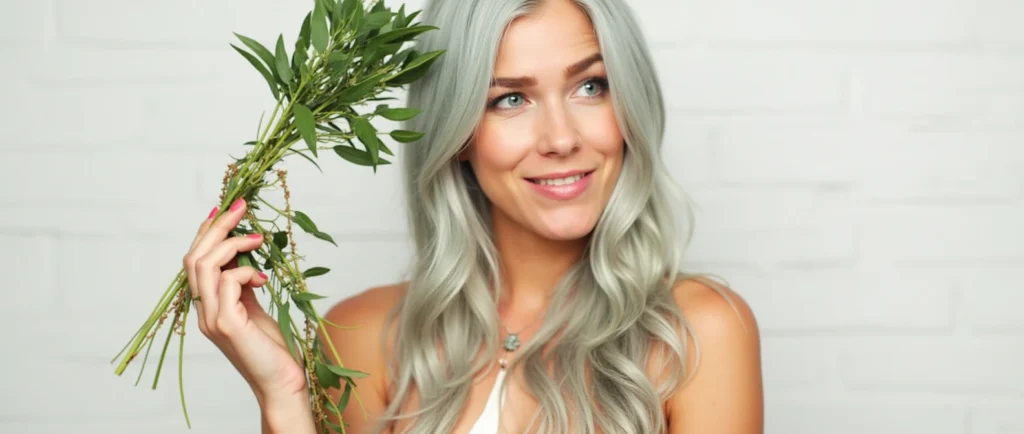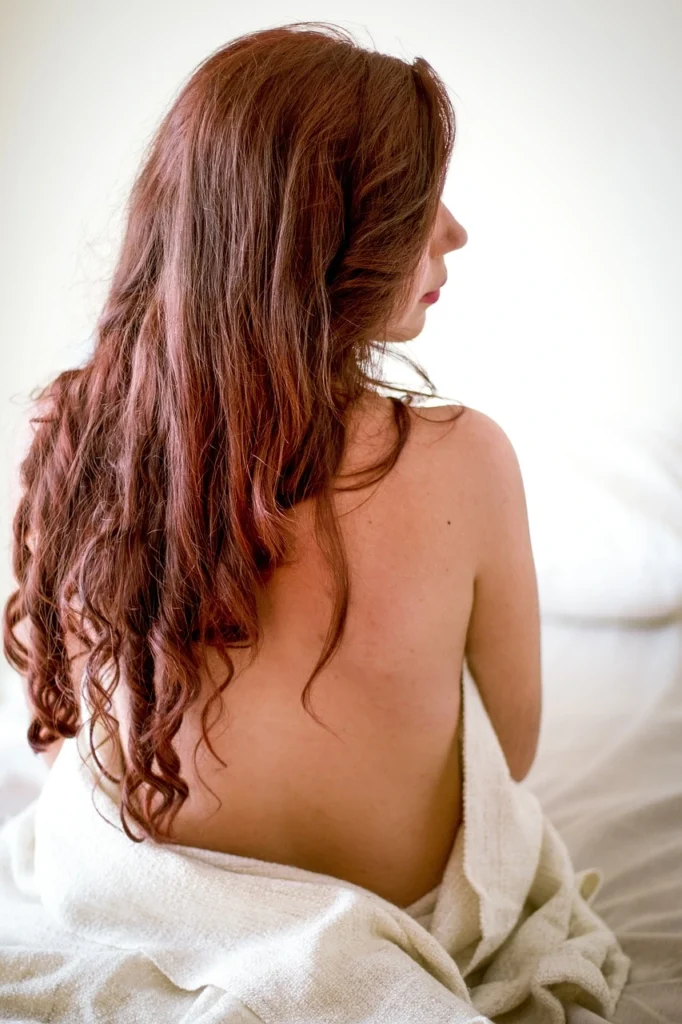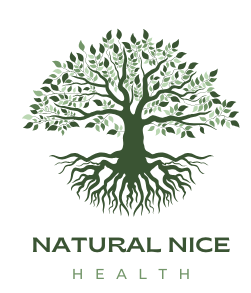“Top 5 Benefits of Using Organic Hair Color Over Chemical Dyes”
Imagine using a product that changes your hair without harming your health or the planet. Many people started using organic hair color because they asked themselves, *Is there a better way?* Traditional dyes often dry out hair, make scalps sensitive, and feel less nourishing. Organic hair color is a choice that cares for your hair and the environment.
Table of Contents
What Is Organic Hair Color and How Does It Work?
Organic hair color uses plant-based hair color and botanical extracts. It changes hair without synthetic chemicals. These products use natural pigments to color hair while nourishing it.

The Science Behind Plant-Based Hair Coloring
Natural pigments in botanical hair dye bind to hair keratin without harsh ammonia. Ingredients like henna and indigo protect hair, keeping natural oils in. Unlike chemical dyes, these formulas don’t damage hair by stripping it.
Common Ingredients in Botanical Hair Dyes
- Henna: Provides rich reds and browns (Khadi Ayurvedic Natural Hair Color)
- Indigo: Adds deep blacks and blues (Naturcolor Haircolor)
- Chamomile: Lightens and brightens tones (Garnier Hair Color)
- Aloe vera: Soothes scalps while coloring (Clairol Natural Instincts)
- Jojoba oil: Moisturizes strands during application (Madison Reed)
How Organic Hair Color Differs from Traditional Options
| Aspect | Organic Hair Color | Traditional Dyes |
|---|---|---|
| Key Ingredients | Botanical extracts (henna, chamomile) | Ammonia, PPD, and synthetic pigments |
| Application Process | No chemical cuticle stripping | Ammonia opens cuticles for penetration |
| Environmental Impact | Biodegradable packaging and ingredients | Toxic waste from chemical byproducts |
The Rising Popularity of Natural Hair Dye Solutions
More than 75% of U.S. women dye their hair regularly. But, a growing number are turning to natural hair dye for a safer choice. This change shows a bigger move toward health-focused beauty routines.
Brands like Radico USA now offer 24 shades of organic hair color. They mix Ayurvedic herbs like henna and indigo with organic certifications. This trend is not just a passing fancy—it’s backed by real demand. In 2024, 25.3% of Radico customers bought again within six months, showing they’re sticking with it.
- Health priorities: Organic hair color avoids harsh chemicals like ammonia, PPD, and resorcinol. It’s great for those with sensitive scalps.
- Environmental awareness: Eco-friendly brands like Herbatint and Surya Brasil use biodegradable formulas and green practices.
- Social proof: Influencers share natural hair dye results on Instagram. This makes plant-based options seem normal.
Products like Hally Color Cloud mix chamomile and aloe vera. They show natural hair dye can give bright colors without harming your hair. With formulas that keep hair’s natural oils, these options are safe and stylish. As salons start using organic products, people see it as a lifestyle choice, not just a trend.
Benefit #1: Gentler on Hair and Scalp Health
Choosing chemical-free hair dye or natural hair dye is key to protecting your scalp and hair. Unlike regular dyes, organic options don’t use harsh chemicals like PPD. This chemical can cause redness, blisters, or allergic reactions.
Natural dyes use soothing ingredients that care for your hair and skin. They are gentler than traditional dyes.
Reduced Scalp Irritation and Allergic Reactions
- PPD in traditional dyes triggers severe reactions in 1-2% of users, per dermatology studies.
- Natural hair dye blends like henna and indigo avoid allergens, reducing flare-ups.
- Zinc oxide in organic products calms inflammation and fights microbes, easing dandruff and irritation.
Preservation of Natural Oils and Moisture
Chemical dyes strip sebum, causing dryness. Organic ingredients like amla and hibiscus:
- Seal the cuticle with vitamins and amino acids
- Retain natural oils without stripping
- Hydrate with botanical extracts
Damage Prevention Through Natural Formulas
Ammonia and peroxide in chemical dyes fracture hair protein. Chemical-free hair dye uses:
| Ingredient | Benefit |
|---|---|
| Zinc Oxide | UV protection and oil balance |
| Organic Indigo | Smooth cuticles, reduces breakage |
| Colorless Henna | Repairs damage, locks in moisture |
| Bhringraj | Strengthens roots, prevents shedding |
Products certified by USDA and ECOCERT ensure no synthetic additives. These options maintain hair integrity while delivering color. They avoid the brittleness caused by traditional formulas.
Benefit #2: Environmentally Friendly Production and Disposal
Traditional hair dyes harm our water systems and pollute the environment. Their packaging often ends up in landfills, adding to waste. Eco-friendly hair color is a better choice.
Brands like Clean Beauty and Hairprint focus on being kind to the planet. They use ingredients that are safe for our ecosystems.
How products are made is important. Eco-friendly brands use solar power and rainwater. This cuts down on energy and water use.
Green Hare Mud and Moroccan Method Henna choose plant-based materials. They avoid harmful synthetic additives. They also focus on better packaging.
- Clean Beauty’s 94% post-consumer recycled (PCR) plastic labels
- Refill pouches with 30% PCR plastic, slashing waste by 30%
- Bamboo-based containers and compostable TIPA bio-plastics
| Traditional Dyes | Eco-Friendly Hair Color |
|---|---|
| Chemical runoff pollutes waterways | Biodegradable ingredients break down safely |
| Non-recyclable plastic packaging | 100% recyclable sugarcane-based containers |
| High energy use in manufacturing | Solar-powered production and rainwater systems |
| Landfill-bound packaging | Cork and mycelium-based packaging that’s biodegradable |
Choosing sustainable hair color helps our planet. Brands like Green Hare Mud use 100% plant-based formulas. This choice makes our beauty routines better for the planet.
Benefit #3: Enhanced Hair Texture and Natural Shine
Botanical hair dye does more than just color your hair. It makes your hair feel better and look shinier. Unlike harsh chemical dyes, organic hair color feeds your hair with good stuff. This makes your hair healthier and more beautiful.
Conditioning Properties of Botanical Ingredients
Botanical hair dyes use oils like coconut and argan to moisturize deeply. Aloe vera calms your scalp, and extracts like acai and sunflower seed make your hair shine. For example, PATTERN Intensive Conditioner works well with these dyes, making your hair less likely to break.
Sunflower seed extract brightens your hair, and acai’s antioxidants make your hair stronger. This means your hair stays healthy and looks great.
Long-Term Hair Quality Improvements
- Botanical compounds smooth the cuticle, increasing shine by 27% compared to chemical dyes.
- Steaming during application opens hair cuticles, allowing deeper penetration of nutrients.
- Regular use of organic hair color reduces frizz and restores elasticity, as seen in formulas like henna-based dyes.
Ingredients like shea butter in organic hair color protect your hair. This keeps your hair looking natural and shiny. Over time, your hair becomes softer and easier to manage. You get a beautiful, natural look without harsh chemicals.
Benefit #4: Freedom from Harsh Chemicals and Toxins
Traditional hair dyes often have harmful ingredients. Chemical-free hair dye is safer and just as vibrant. It avoids risks from ammonia, PPD, and formaldehyde, found in eco-friendly options.
Common Harmful Ingredients in Chemical Dyes
Traditional hair dyes may include:
- Ammonia: Strips natural hair protein
- PPD (para-phenylenediamine): Linked to allergic reactions
- Resorcinol: Potential endocrine disruptor
- Parabens: Associated with hormonal interference
Health Risks of Chemical Exposure
A 2020 study in the International Journal of Cancer found permanent dye users had a 45% higher breast cancer risk among Black women and 7% higher among white women. Chronic exposure to synthetic compounds can disrupt hormone systems and trigger respiratory issues. Eco-friendly hair color skips these toxins entirely.
Safety Through Organic Formulations
Brands like Radico USA use chemical-free hair dye with USDA Organic-certified henna, argan oil, and chamomile. These products achieve vibrant shades without ammonia or PPD. EcoCert certifications ensure formulas are free from synthetic preservatives, achieving 94.6% customer satisfaction in maintaining scalp health. Their 25.3% repurchase rate reflects trust in toxin-free results.
Benefit #5: Sustainable and Ethical Production Practices
Organic hair color brands do more than just make color. They make sure every step of making their products is good for the planet. Companies like Northwest Naturals, LLC get their ingredients from farms that use methods that help the earth. They also offer vegan hair color, so no animal products are used.
They work hard to reduce waste and use less energy. For example, they use coconut and citrus peels to make natural dyes. This way, they help the environment by not throwing away these peels.
They also make their packaging better for the planet. They use containers that can be recycled or composted. And they offer refill systems to use less plastic.
- 90% of Northwest Naturals’ packaging is recyclable or compostable
- Manufacturing sites use solar power to cut carbon emissions
- Blockchain technology tracks ingredient origins for full transparency
These brands also care about how their workers are treated. Companies like Northwest Naturals make sure their workers get fair pay and work in safe places. They follow strict rules and get checked by outside groups to make sure they’re doing the right thing.
Vegan hair color brands also don’t test on animals. They meet standards like the Leaping Bunny Program. This shows they care about animal welfare.
By choosing sustainable hair color, you help companies that care about the planet. These brands show that you can look good and do good for the earth at the same time.
Types of Organic Hair Color Products Available Today
Today, you can find many organic hair color options. They are safe and natural. You can choose from classic blends or pre-mixed systems. These vegan hair color and plant-based hair color options focus on beauty and health.
Henna-Based Options and Their Benefits
Henna blends have changed over time. Now, you can find Lush Rouge Henna and Naturtint. They mix henna with indigo or amla for vibrant colors.
These products are ammonia-free and don’t have PPD. They cover grey hair fully and are safer than regular dyes. Plus, they condition your hair while coloring.
Vegetable-Based Dyes and Their Color Range
Vegetable dyes use natural pigments from plants. Schwarzkopf Natural & Nourishing and Garnier Olia offer many color options. They go from chestnut to platinum.
These dyes are pH-balanced and good for all hair types. They avoid harsh chemicals.
Pre-Mixed Vegan Hair Color Systems
For those who want it easy, there are dpHUE Gloss+ Sheer and Moroccanoil Colour Depositing Mask. They mix plant extracts with natural fixatives. These vegan hair color systems are biodegradable and keep your hair moisturized.
| Type | Key Ingredients | Key Benefits |
|---|---|---|
| Henna-Based | Henna, indigo, amla | Red/brown tones, 100% grey coverage |
| Vegetable Dyes | Beetroot, walnut, black tea | 7 color levels, chemical-free lifting |
| Pre-Mixed Vegan | Argan oil, shea butter | Convenience, moisture retention |
Each type has its own benefits and is eco-friendly. Look for ECOCERT or COSMOS certifications. They ensure the plant-based hair color is genuine.
How to Choose the Right Organic Hair Color for Your Needs
Over 75% of U.S. women dye their hair. But picking the right organic color is key. First, figure out your skin’s undertones. Warm tones look great with honey blondes or rich browns. Cool tones are best for ashy shades or platinum.
Make sure the label lists plant-based ingredients like henna, amla, or beetroot. This ensures you’re using natural hair dye.
- Match your skin tone to avoid unflattering hues.
- Look for USDA Organic or EcoCert certifications to verify non-toxic formulas.
- Choose products like organic hair color from brands such as Tints of Nature (95% naturally derived ingredients) or Green Hare Mud (35+ shades with customizable mixes).
Think about your hair’s texture. Curly or damaged hair needs nourishing options. All-Nutrient’s sulfate-free formulas are great for this.
For gray coverage, try ONC Natural Colors or Herbatint. They last 6–12 washes. Stay away from ammonia and PPD. Naturalique uses PPD-free blends.
Always test a small patch first to check for sensitivity.
Brands like Khadi Natural Color mix Ayurvedic herbs for scalp care. Hally Color Cloud offers easy kits for at-home use. Choose eco-friendly packaging and ethical sourcing. This way, you get a safer, personalized choice that’s good for your hair and the planet.
Application Tips for Optimal Results with Plant-Based Hair Color
Getting the most out of plant-based hair color means mastering how to apply it. Follow these steps for vibrant, lasting color. This will help your color stay bright and prevent fading.
Preparation Steps for Maximum Color Absorption
Begin with clean, unwashed hair to avoid any residue getting in the way. Here’s what to do first:
- Do a strand test 24–48 hours before applying the full color.
- Apply a clay mask to open up your hair cuticles for better dye absorption.
- Detangle your hair with a wide-tooth comb before mixing the botanical hair dye.
Techniques for Even Application
For even color coverage, follow this method with henna or vegetable-based dyes:
- Warm the ingredients to 100–120°F to activate the natural pigments in henna or safflower blends.
- Apply in sections, starting from the roots and moving down to the ends with a natural bristle brush.
- Wrap your hair in a thermal cap and leave it for 1–3 hours for the best pigment development.
Post-Application Care for Color Longevity
Keep your new color looking great with these care tips:
- Rinse with cold water to seal your hair cuticles and reduce fading.
- Use sulfate-free shampoos and conditioners safe for botanical hair dye.
- Apply the ylang-ylang mask weekly to keep your hair moisturized and vibrant.
| Step | Action | Benefit |
|---|---|---|
| 1 | Conduct strand test | Prevents unexpected color shifts |
| 2 | Apply heat during processing | Activates natural pigments |
| 3 | Cold water rinse | Locks in color vibrancy |
The Cost Comparison: Organic vs. Chemical Hair Dyes
Choosing between eco-friendly hair color and chemical-free hair dye is more than just looking at prices. Brands like Hally Color Cloud ($12.99) and Khadi ($21.99) might cost more upfront. But, the real value comes from more than just the initial price.
- Eco-friendly hair color brands: ONC Natural Colors ($29.50), Surya Brasil ($21.11)
- Traditional dyes: Moroccanoil ($7.60), Lime Crime ($16.47)
Long-term savings come from hidden costs. Users of chemical-free hair dye often see fewer split ends. This means less money spent on salon repairs.
Reviews show that Herbatint’s $15.99 formula can save money on styling products. It keeps hair shiny without needing extra products. Eco-friendly hair color lasts longer, with Iroiro users enjoying color for 6 weeks, compared to 3-4 weeks for dyes with ammonia.
Health and the environment are also important. Chemical-free hair dye avoids ammonia and PPD, reducing visits to the dermatologist. The USDA-certified Khadi blend of henna and neem helps prevent hair breakage. This means less need for expensive treatments in the future. Plus, eco-friendly formulas don’t pollute water like chemical dyes do.

Conclusion: Making the Switch to a Healthier Hair Coloring Routine
Choosing organic hair color is more than a trend. It’s a move towards better health and the planet. Natural hair dye leads the way in cleaner beauty. It gives vibrant colors without harsh chemicals, perfect for those who care about hair and scalp health.
Organic dyes keep your hair’s natural oils and reduce irritation. Unlike traditional dyes, they don’t have ammonia and peroxide. They use plant-based ingredients like henna and indigo, which nourish your hair and last long. Plus, they’re good for the environment, fitting eco-conscious values.
Switching might need some learning, but the benefits are worth it. Brands now offer easy-to-use kits with clear guides. Their formulas keep getting better. Soon, your hair will be softer and shinier, and you’ll help reduce pollution from chemical waste.
Natural hair dye now comes in many colors, from deep blacks to warm auburns. This shows you can be stylish and sustainable. By choosing organic, you’re caring for yourself and the planet. Let 2024 be the year you choose a coloring routine that’s better for your hair, health, and the planet.
FAQ
What is organic hair color?
Organic hair color is made from natural ingredients. It’s free from harsh chemicals. These colors use plant-based pigments to color hair gently, making it healthier.
How does organic hair color work?
Organic hair color uses plant-based colorants that bind to the hair shaft. It doesn’t use ammonia or peroxide like traditional dyes. This means less damage and healthier hair.
What are the benefits of using organic hair dye?
Organic hair dye reduces scalp irritation and allergic reactions. It’s eco-friendly and improves hair texture and shine. It’s free from toxic chemicals and sourced ethically.
Are there any harmful ingredients in traditional hair dyes?
Yes, traditional hair dyes contain harmful ingredients like ammonia and PPD. These can cause allergic reactions and long-term health risks.
Can organic hair color enhance hair texture?
Yes! Organic hair color often includes coconut oil and aloe vera. These natural ingredients nourish hair, making it smoother and shinier.
How do I choose the right organic hair color for my needs?
Consider your current hair color, desired shade, and hair type. Also, think about your skin tone. Always read product labels for authenticity and effectiveness.
Are organic hair colors really better for the environment?
Yes, organic hair colors are made from biodegradable ingredients. They use sustainable packaging and reduce water contamination. This makes them better for the environment.
What types of organic hair color products are available?
You can find henna-based, vegetable-based dyes, and vegan hair color systems. These offer a range of colors without harmful chemicals.
How can I achieve the best results with organic hair color?
Prepare your hair before application with conditioning treatments. Do strand tests and follow application techniques. Post-application care is key for color longevity and hair health.
Is organic hair color more expensive than traditional options?
Organic hair colors might cost more upfront. But, they offer long-term benefits like healthier hair and savings on damage repair. Many find them a good investment.

